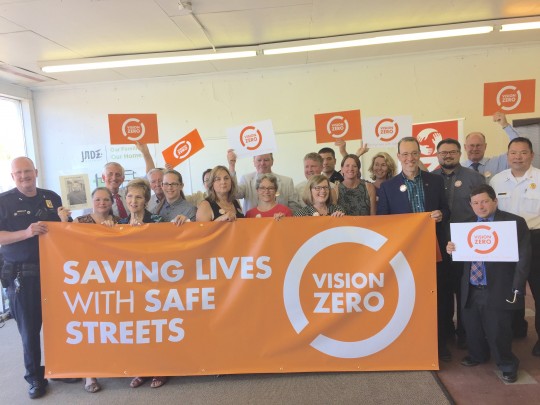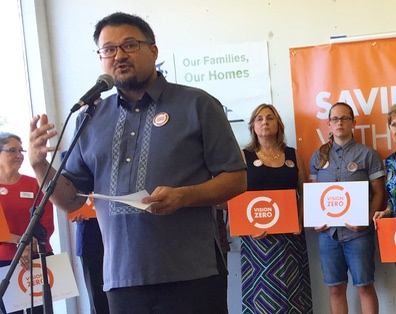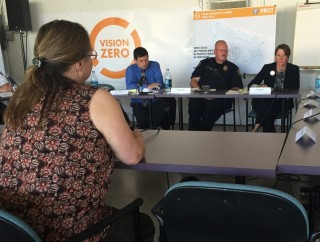Usually when we talk about preventing road injuries and deaths we have the usual suspects around the table — biking and walking advocates and transportation agency staffers. The power of Vision Zero lies in its ability to broaden the circle of concern about traffic safety.
Yesterday at the kickoff of Portland’s Vision Zero Task Force, we saw that power in action. The event was hosted by the non-profit Asian Pacific American Network of Oregon (APANO), a group that advocates for the rights and interests of Asian and Pacific Islanders. APANO’s Executive Director, Joseph Santos-Lyons, kicked off the event by saying that improving traffic safety is important to the people and the neighborhoods he represents.
APANO is headquartered in Portland’s “Jade District” — a moniker given to the commercial area around SE 82nd and Division. It’s an area full of renewed optimism, thanks in large part to APANO’s Jade Night Market (happening again this Saturday 8/22), but it’s also one of the most dangerous areas in the city to walk, bike, or drive a car. Last night there were two families in attendance who had lost a loved one in a traffic crash just a few blocks away.
“I’m in. We’re all in. We can make a difference.”
— Mayor Hales
“Vision Zero is a priority for us,” Santos-Lyons said before introducing Mayor Charlie Hales, “Our Jade community has been directly affected. These crashes are not only tragic, they are preventable.”
The fact that we can do something about traffic crashes was a strong theme throughout the event (and thankfully got picked up in media coverage).
Mayor Hales spoke about Vision Zero with more strength and conviction than I’ve seen from him in the past. Standing in front of an impressive group of electeds, agency leaders, and other Task Force members, he made the case that — despite all the shootings in the news each week — traffic fatalities and injuries have a higher “human cost” in Portland (statistically-speaking) than gang violence. To make things better, Hales said we shouldn’t drive unless we have to and when we do, we should, “give deference to pedestrians and cyclists,” because, “they’re the vulnerable ones.”
“For Vision Zero to work, we’re not going to get there alone.”
— Margi Bradway, PBOT Active Transportation Division Manager
And his final line made it clear he’s ready to take at least some responsibility to make things better: “I’m in. We’re all in. We can make a difference.”
After opening speeches, Hales was asked by a reporter how he’ll get people to change behaviors. “The language we use is important,” was his reply. That’s a good answer. A major rally in New York City last month was focused on getting people to use the word crash, not “accident” when talking about collisions. Hales then encouraged the reporter to, “Spread the message that this is a social responsibility for each of us.” “Having a driver’s license is a privilege,” he continued, “No one has the right to drive a car.”
After opening speeches, leaders from agencies partnering on the Vision Zero effort sat down for their first meeting. Around the table were TriMet General Manager Neil McFarlane, Metro Councilor Bob Stacey, Deputy Fire Chief Leo Krick, Commissioner Steve Novick, Police Chief Larry O’Dea, PBOT Director Leah Treat, Oregon State Senators Michael Dembrow and Diane Rosenbaum, Oregon State Representative Alissa Keny-Guyer, and ODOT Region 1 Director Rian Windsheimer.
Advertisement
(This may seem like just another meeting, but this was the first time all of these leaders came together for Vision Zero. Not only are they now getting educated about what it means, they are also feeling the peer pressure to support the initiative from a broad cross-section of community leaders, bureaus, and advocacy groups. And for what it’s worth, everyone pledged their full support for Vision Zero yesterday. There were no hair-splitters or fence-sitters.)
“Where do families stand on this Task Force? Are we going to be asked to be on the Task Force? Are you going to ask for our opinions? It’s going to be us with our quivering and grieving voices — not politicians — who will touch people’s hearts.”
— Kristi Finney, mother of Dustin Finney
Metro’s role in Vision Zero will have more to do with funding than anything else, since they control federal pursestrings to the tune of about $16 million for Portland each year. Councilor Stacey said that money needs to be allocated “through a Vision Zero lens.” On a related funding note, Senator Dembrow said, “We’ll need to pass a transportation package in order to really bring Vision Zero to fruition.”
I was curious to hear how Windsheimer at ODOT would frame his support of Vision Zero. So far the most powerful road agency in the region (and the one whose roads claim the most victims), hasn’t committed to achieving zero road deaths and injuries. Instead, ODOT’s top traffic safety official said back in November that there approach is to increase the number of individual days when no one dies.
Yesterday Windsheimer made it seem like ODOT has supported the idea all along. “We’ve had a goal for a number of years,” he said, “to have zero injuries and fatalities.” Was that peer pressure in action? Either way, it appears we can now add ODOT to list of agencies committed to Vision Zero. Windsheimer also shared a phrase that irks some activists because it’s too soft on motor vehicle operators. “It doesn’t matter what mode you travel, safety is everyone’s responsibility.”
It will also be everyone’s responsibility to find funding to pay for new safety efforts — whether they include marketing and PSAs and/or projects on the ground. On that note, Novick fearlessly brought up his controversial (and “paused”) street fee effort. “At some point,” he said, “we’re going to have another discussion about raising revenue for transportation.” He acknowledged that one mistake made in pushing for the street fee last year was that the city didn’t do more to soothe feelings between the Bicycle Transportation Alliance and the Portland Business Alliance. Instead of working together, those two groups’ advocacy devolved into a fight over how the money should be split up (the BTA wanted 50/50 safety/maintenance and the PBA wanted 25/75). “We should have gotten them into a room together to make that argument not so vehement.”
If we rely on funding to make progress on Vision Zero, it might never happen. Much of this effort is about created a movement and upping the public urgency that the way we use our roads needs to change.
Kristi Finney took the day off work to be at yesterday’s event. Finney lost her son Dustin four years ago when a drunk driver hit him while he biked Division just four blocks away. She stood up and addressed the electeds and agency leaders: “Where do families stand on this?” she wondered. “Are we going to be asked to be on the Task Force? Are you going to ask for our opinions? It’s going to be us with our quivering and grieving voices — not politicians — who will touch people’s hearts.”
While Finney’s words made an impact, Portland’s official efforts at the moment are more about amassing the institutional and political support it will take to find funding and change policies. And on that note, Margi Bradway, leader of PBOT’s Active Transportation Division and a former advisor for ODOT Director Matt Garrett, deemed yesterday a success.
Bradway was pleased to see all the partners who showed up and pledged support to the effort. “For Vision Zero to work, we’re not going to get there alone,” she said. “Vision Zero provides a framework for the discussion, and it’s that framework that comes into play when major decisions have to be made and everyone thinks of Vision Zero.”
See the full membership list and meeting schedule of Portland’s Vision Zero Task Force here.




